Samsung Galaxy S7 and S7 Edge review: The best smartphones, period
Samsung’s Galaxy S7 and S7 Edge offer a veritable greatest hits list of smartphone features: They combine the looks of the company’s Galaxy S6 and S6 Edge with the waterproof design and expandable storage of the Galaxy S5 to make two beautiful and durable new smartphones.
But the S7 and S7 Edge don’t just rehash old ideas. They also bring a host of new and interesting features. That combination of new meets the best of the old make these not just the best smartphones Samsung has ever built — but, in my opinion, the best smartphones you can buy right now.
Here’s why.
Design and size
OK, yeah, the Galaxy S7 and S7 Edge look a lot like their predecessors, the S6 and S6 Edge. And while the Edge has a larger display this time around, most people would have trouble telling the new and old models apart.
That’s not necessarily a bad thing, though. The S6 and S6 Edge were beautiful phones, and so are the S7 and S7 Edge. And remember that Apple regularly recycles the body designs of its iPhones in a two-year cycle, using the second year to update the handsets’ guts, before coming out with a new exterior the year after that. That’s the same game Samsung appears to be playing here.
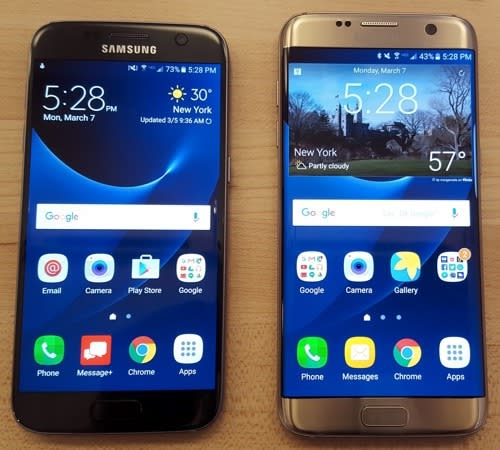
Like the S6 and S6 Edge, the S7 and S7 Edge come wrapped in metal frames with glass-coated rear panels. Those rear panels look great, though I must point out that they are also “magnets” for fingerprint smudges.
Unlike last year’s models, the S7 and S7 Edge have contoured rear panels that make them more comfortable to hold. Samsung has also reduced the size of the phones’ camera bumps, making them more flush with the handsets’ bodies.
Measuring 5.6 x 2.7 x 0.31 inches, the S7 is nearly identical to the S6 in terms of size, and is a bit thicker and taller than the iPhone 6s — but Samsung’s handset does offer a larger screen.
The Galaxy S7 Edge, on the other hand, is much larger than the S6 Edge, measuring 5.9 x 2.9 x 0.3 inches, which accommodates its bigger 5.5-inch screen. Still, the S7 Edge is shorter than the iPhone 6s Plus (6.2 x 3.1 x 0.29 inches) which also has a 5.5-inch screen.
Dare to get wet
Water is usually a death sentence for smartphones. A few years ago, Samsung solved this problem by making its Galaxy S5 waterproof. But when the S6 came out, Samsung for some reason removed that incredibly helpful feature.
Thankfully, the company came to its senses and brought waterproofing back for the S7 and S7 Edge. Both phones can survive in up to five feet of water for up to 30 minutes and emerge unscathed.
I put both phones in a large container of water, and when I pulled them out, they still worked perfectly. What’s more impressive is that the S7 and S7 Edge don’t have any unsightly port covers to keep them safe from water.
This is a super-practical feature every smartphone should offer. Now if only Apple would get the message.
Beautiful screens
Samsung’s smartphones generally sport some of the best-looking displays you can find, and the S7 and S7 Edge are no different. The Galaxy S7 comes with a 5.1-inch, 2560 x 1440 resolution Super AMOLED display, while the S7 Edge gets a 5.5-inch version of the same screen.
Super AMOLED (active matrix of organic light-emitting diodes) displays are known for offering striking colors and deep blacks (though, by the same token, their colors can sometimes look abnormally oversaturated). By comparison, Apple’s iPhone Retina HD screens tend to produce colors that, while brilliant, are slightly flatter — and, as a result, more natural-looking — than what you’ll see on Samsung phones. I happen to prefer vibrant colors, so I also prefer Samsung’s screens.
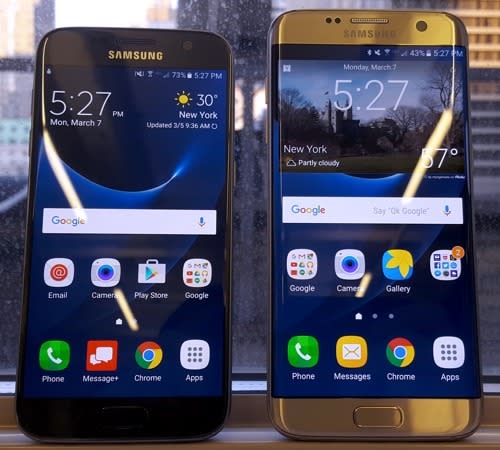
For the S7 and S7 Edge, Samsung has introduced the always-on display. As the name implies, these displays are, well, always on. Whenever the phone is locked, the screen will show things like the time, date, battery level, your calendar or an image like a night sky on a largely black background. You can also see notifications for things like texts and missed calls.
I set the screen to show the time, and sat it down on my desk to act as my desk clock. I found that to be surprisingly helpful, as it meant I didn’t have to constantly grab my phone and wake it up just to check the time.
Because that AMOLED technology actually turns off individual pixels to display blacks (instead of keeping them lit), this always-on feature shouldn’t eat through the phones’ batteries. In fact, the company claims it will use just 1 percent of your handset’s battery life.
If, however, you don’t want to risk even a tiny loss of battery power, you can always turn off the feature altogether in the Settings menu.
Bleeding edge
The biggest difference between the S7 and S7 Edge is the latter’s curved Edge screen. Like the S6 Edge, the S7 Edge’s display cascades off its left and right sides, giving the appearance of a completely edgeless display. It’s really quite beautiful.
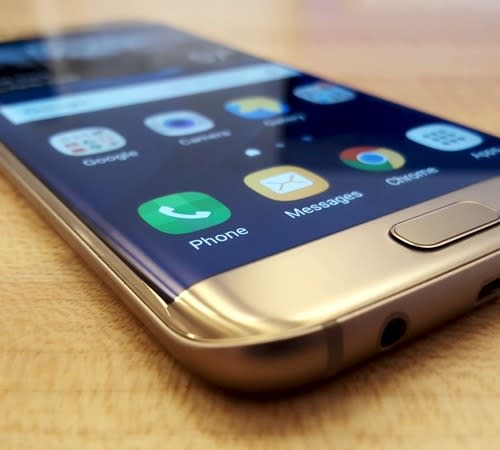
With the S6 Edge, the curved screen was frankly more of a gimmick than anything. But with the S7 Edge, the Edge display is far more functional. By swiping in from either side of the screen you can pull up a list of your favorite apps or select specific tasks (such as texting particular people or opening the camera to take a selfie).
News stories, sports scores, and stock prices summoned this way also appear larger (and, so, easier to read). With the S6 Edge, those things were shown as a scrolling ticker that ran along the Edge display. Now they’re big boxes with images and readable text.

All of which is to say that the S7 Edge’s Edge display is extremely useful in its current incarnation. My one problem with it is that, when I type a message using one hand, my palm ends up hitting the curved portion of the screen, causing me to press a button I didn’t mean to. You can imagine how annoying that can be after a while.
Take pictures anywhere
The Galaxy S7 and S7 Edge both come with 12-megapixel rear cameras, just like the iPhone 6s and 6s Plus. Samsung’s new cameras actually have fewer megapixels than the 16-megapixel shooters found on the S6 and S6 Edge.
That’s not exactly a downgrade, though, as the S7 and S7 Edge’s pixels are larger than their predecessors. As a result, Samsung says the S7 and S7 Edge’s cameras can capture more light, which makes for clearer, more colorful images.
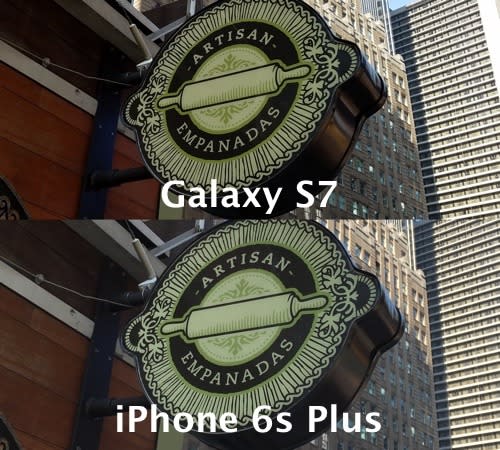
That said, when I compared shots taken outside and in my office with the S6 to those taken with the S7, I didn’t notice much of a difference.
But compared to photos taken with the iPhone 6s Plus, the Galaxy S7’s shots seemed to offer more saturated colors and slightly sharper details (though, to be honest, you’ll have to zoom in on your pictures to see any appreciable difference). As before, the iPhone still makes the sky look bluer than Samsung’s phones.
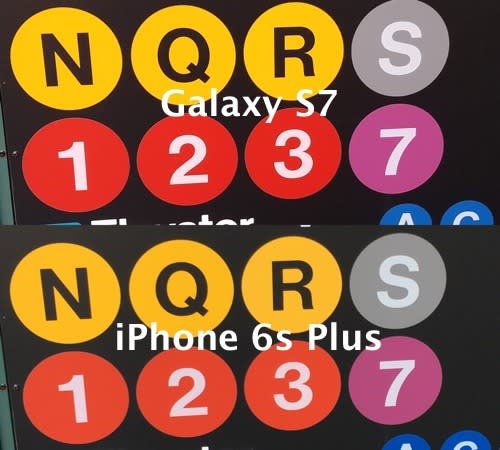
In low-light situations, though, the S7 absolutely blows away the competition. A picture I took of my lounging cat with the S7 was far brighter and offered more details than the same shot taken on the iPhone 6s Plus. My one gripe is that the photo taken with the S7 gave my cat’s white fur a yellow tint — but there’s no denying that the overall image was easier to read.
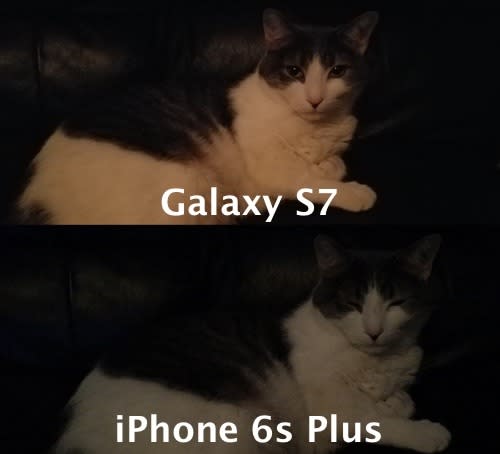
Speedy, expandable
Inside, the S7 and S7 Edge are virtually identical. Both phones have high-powered processors and 4 GB of RAM, which means apps run buttery smooth. I was especially impressed with how quickly the S7 and S7 Edge’s fingerprint readers unlock the phones.
But the one feature that will have hardcore smartphone users jumping with joy is the return of expandable storage. Yep, when you run out of space on your S7, you don’t have to worry about deleting a bunch of photos and apps to make more room.
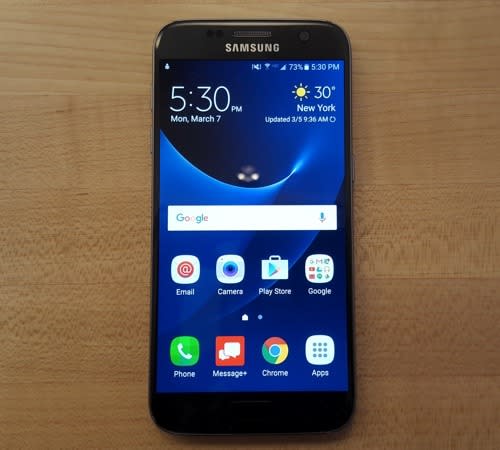
Instead, you can just slide a microSD card into the handset and add up to 200 GB of storage. That’s a big benefit, especially if you take a lot of pictures or download movies to watch on the go.
In terms of battery life, the S7 and S7 Edge come with 3,000-mAh and 3,600-mAh power plants, respectively. That’s a nice upgrade over the Galaxy S6 and S6 Edge, which came with 2,550-mAh and 2,600-mAh batteries. That means the S7 and S7 Edge should get you through your day and then some without needing to be recharged.
Software with a bit of bloat
Both the S7 and S7 Edge run the latest version of Google’s Android Marshmallow operating system with Samsung’s TouchWiz skin running on top.
In previous years, I would have bemoaned Samsung’s decision to alter Android by adding its own app icons and certain interface changes. But ever since releasing the Galaxy S6, Samsung has cut back on how much of its own mark it puts on Android with its interface. The result is a relatively slick interface that is easy to navigate without being overbearing or holding your hand too much.
The biggest problem I have with the S7 software is the huge number of unwanted apps (a.k.a. bloatware) that come preinstalled. In addition to Google’s usual slew of apps, Samsung installs its own offerings, including its Milk Music service and a host of Amazon apps. My S7 and S7 Edge also came with eight different Verizon apps. I hate preinstalled apps, but companies just keep adding more and more of them.
The bottom line
Despite these quibbles, however, the Galaxy S7 and Galaxy S7 Edge are easily the best smartphones you can currently buy. They are beautiful, waterproof and capture fantastic photos.
Between the S7 and S7 Edge, though, I’d suggest opting for the S7, simply because it’s less expensive. Sure the Edge is more attractive, and its expanded screen makes opening apps easier. But at $792 for my Verizon version, it costs $120 more than the regular S7. If cost isn’t an issue, go ahead and splurge for the Edge. Either way, you won’t be disappointed.
Email Daniel at dhowley@yahoo-inc.com; follow him on Twitter at @DanielHowley.
